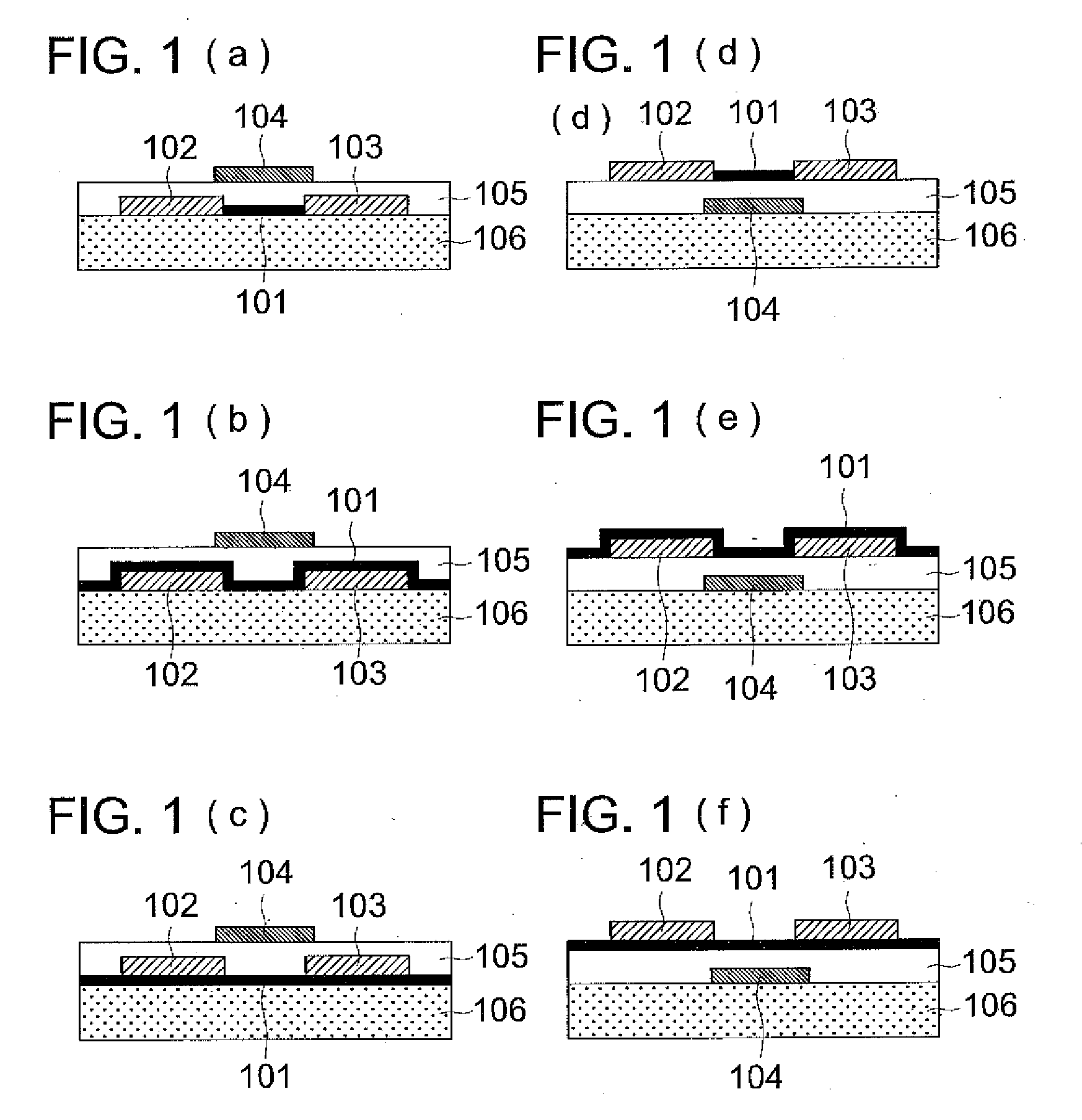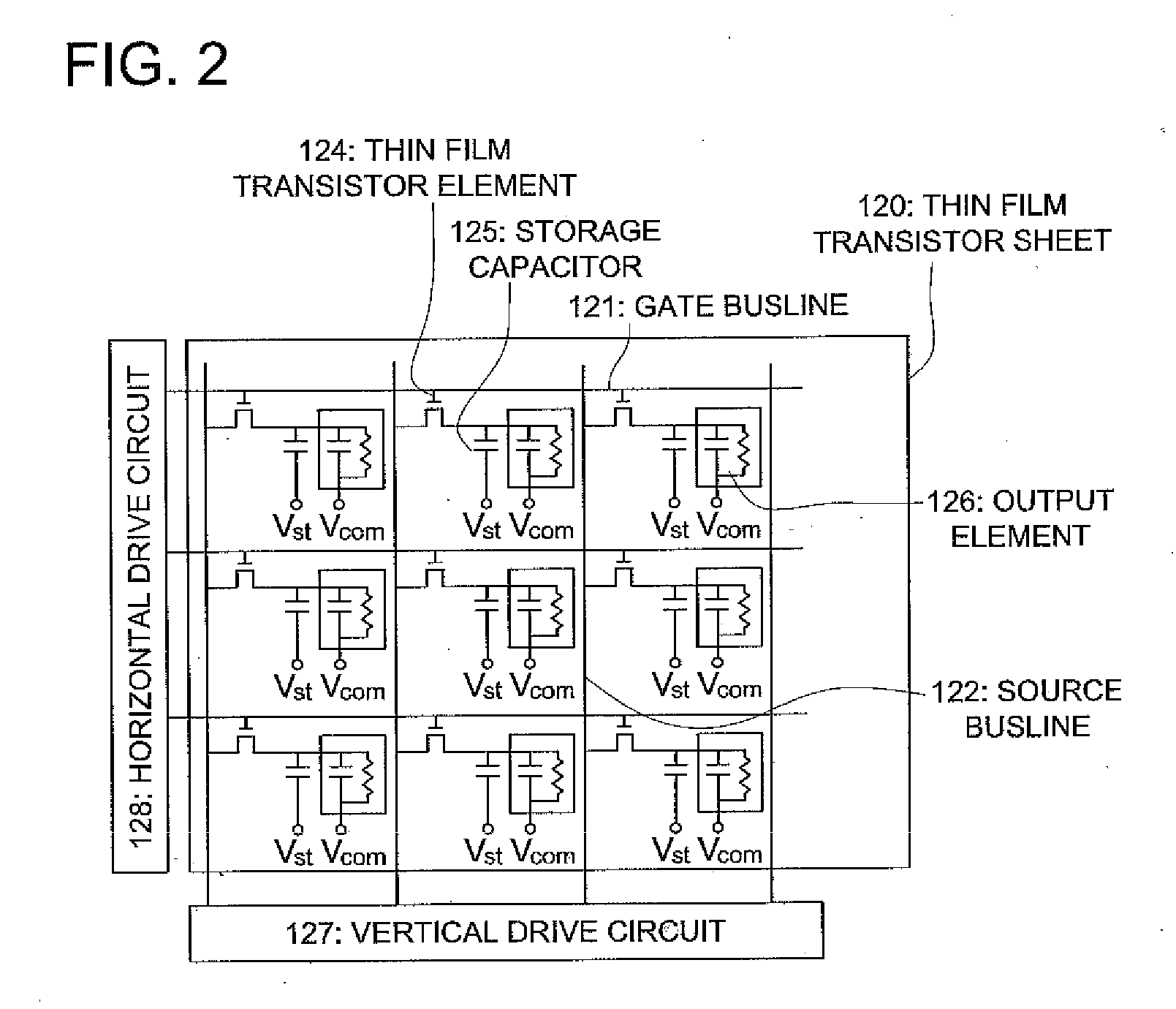Metal oxide semiconductor, semiconductor element, thin film transistor and method of manufacturing thereof
a metal oxide semiconductor and manufacturing method technology, applied in the direction of semiconductor devices, basic electric elements, electrical appliances, etc., can solve the problems of difficult application of light and flexible resin substrates, low energy efficiency, and relatively long processing time, and achieve high manufacturing efficiency
- Summary
- Abstract
- Description
- Claims
- Application Information
AI Technical Summary
Benefits of technology
Problems solved by technology
Method used
Image
Examples
example 1
[0122]In FIGS. 3(1)-3(4), schematic cross-sectional views illustrating the manufacturing process of a thin film transistor are shown.
(Manufacturing of Thin Film Transistor Element 1)
[0123]As substrate 6, an alkali-free glass substrate was used, and an ITO film having a thickness of 150 nm was formed all over the substrate by sputtering. Then, the ITO film was subjected to patterning via photolithography to form gate electrode 4.
[0124]Subsequently, gate insulating layer 5 composed of 200 nm thick silicon oxide was formed by an atmospheric pressure plasma CVD method. The atmospheric pressure plasma treatment apparatus disclosed in FIG. 6 of JP-A No. 2003-303520 was used.
(Gases used)Inert gas: helium98.25%by volumeReactive gas: oxygen gas1.5%by volumeReactive gas: tetraethoxysilane vapor0.25%by volume(bubbled with helium gas)
(Discharge conditions)High frequency power source:13.56MHzDischarge power:10W / cm2
(Electrode Conditions)
[0125]The electrode is a grounded roll electrode having a di...
example 2
[0159]Similarly, a bottom gate-top contact thin film transistor element of which schematic cross-sections were shown in FIGS. 4(1)-4(5) were manufactured.
[0160]A polyimide film (200 μm in thickness) was used as substrate 6. Corona discharge treatment was carried out at a condition of 50 W / m2 / min on the substrate, followed by forming a subbing layer as follows to improve the adhesion.
(Formation of Subbing Layer)
[0161]The coating liquid having the following composition was applied so that the dry thickness was 2 μm, followed by drying at 90° C. for 5 minutes, and then was subjected to hardening using a high-pressure mercury lamp of 60 W / cm at a distance of 10 cm for 4 seconds.
Dipentaerythritol hexaacrylate monomer60gDipentaerythritol hexaacrylate dimer20gComponent of dipentaerythritol hexaacrylate trimer or larger20gDiethoxybenzophenone UV initiator2gSilicone surfactant1gMethylethyl ketone75gMethylpropyleneglycol75g
[0162]Further, atmospheric pressure plasma treatment was continuously ...
example 3
[0176]Thin film transistor elements having different compositions were manufactured by varying the ratio of indium nitrate [In(NO3)3], zinc nitrate [Zn(NO3)2] and gallium nitrate [Ga(NO3)3] as raw materials of the semiconductor precursor (FIG. 5).
[0177]On a silicon wafer having a specific resistance of 0.02 Ω / cm as gate electrode 4, a 2000 Å thick of thermal oxidation film was formed to obtain gate insulating layer 5.
[0178]Hereafter, this is called as a substrate. The substrate was then cleaned by being irradiated with a UV light for 10 minutes at 70° C. under a circumstance of ozone.
[0179]Next, a metal salt coating solution was prepared as a precursor material.
[0180]The nitrates of In, Ga, and Zn were mixed and dissolved in pure water so that the concentration of the sum of the nitrates was 10% by mass. The mixture was dispersed for 10 minutes using ultrasound.
[0181]Subsequently, the product was passed through a filter having a mesh diameter of 0.2 μm and treated by ultrasound for ...
PUM
| Property | Measurement | Unit |
|---|---|---|
| temperature | aaaaa | aaaaa |
| frequency | aaaaa | aaaaa |
| temperature | aaaaa | aaaaa |
Abstract
Description
Claims
Application Information
 Login to View More
Login to View More - R&D
- Intellectual Property
- Life Sciences
- Materials
- Tech Scout
- Unparalleled Data Quality
- Higher Quality Content
- 60% Fewer Hallucinations
Browse by: Latest US Patents, China's latest patents, Technical Efficacy Thesaurus, Application Domain, Technology Topic, Popular Technical Reports.
© 2025 PatSnap. All rights reserved.Legal|Privacy policy|Modern Slavery Act Transparency Statement|Sitemap|About US| Contact US: help@patsnap.com



